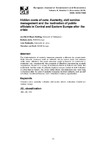Hidden costs of cuts: Austerity, civil service management and the motivation of public officials in Central and Eastern Europe after the crisis

View/
Use this link to cite
http://hdl.handle.net/2183/23442Collections
Metadata
Show full item recordTitle
Hidden costs of cuts: Austerity, civil service management and the motivation of public officials in Central and Eastern Europe after the crisisDate
2016Citation
Meyer-Sahling, J.-H., Janta, B., Reinholde, I., & van Stolk, C. (2017). Hidden costs of cuts: Austerity, civil service management and the motivation of public officials in Central and Eastern Europe after the crisis. European Journal of Government and Economics, 5(2), 120-137. https://doi.org/10.17979/ejge.2016.5.2.4320
Abstract
[Abstract] The implementation of austerity measures presents a dilemma for governments. While austerity measures such as cutbacks aim to reduce costs and enhance public sector efficiency, the same measures might undermine the motivation of employees and, consequently, the prospects of effectively implementing austerity programmes. Based on a survey of ministerial officials in Poland and Latvia, this article finds that the scale of cutbacks explains a larger decline of staff motivation in Latvia than in Poland. The article further shows that motivation was more likely to decrease after the crisis if austerity measures involved cutbacks such as staff reductions, recruitment freezes, and a reduction of training opportunities.
Keywords
Economic crisis
Austerity
Civil service reform
Motivation
Central and Eastern Europe
Austerity
Civil service reform
Motivation
Central and Eastern Europe
Editor version
Rights
Atribución 4.0 España
ISSN
2254-7088






